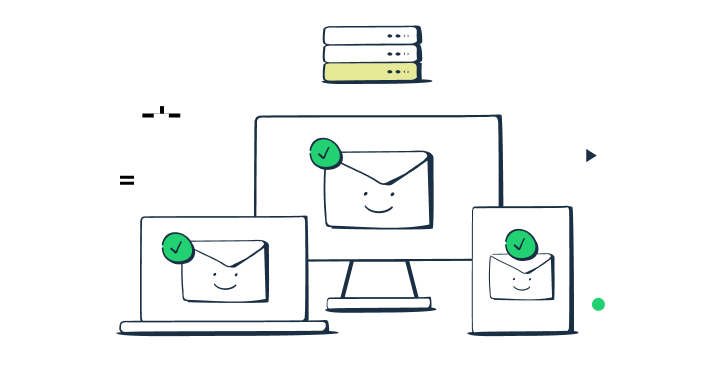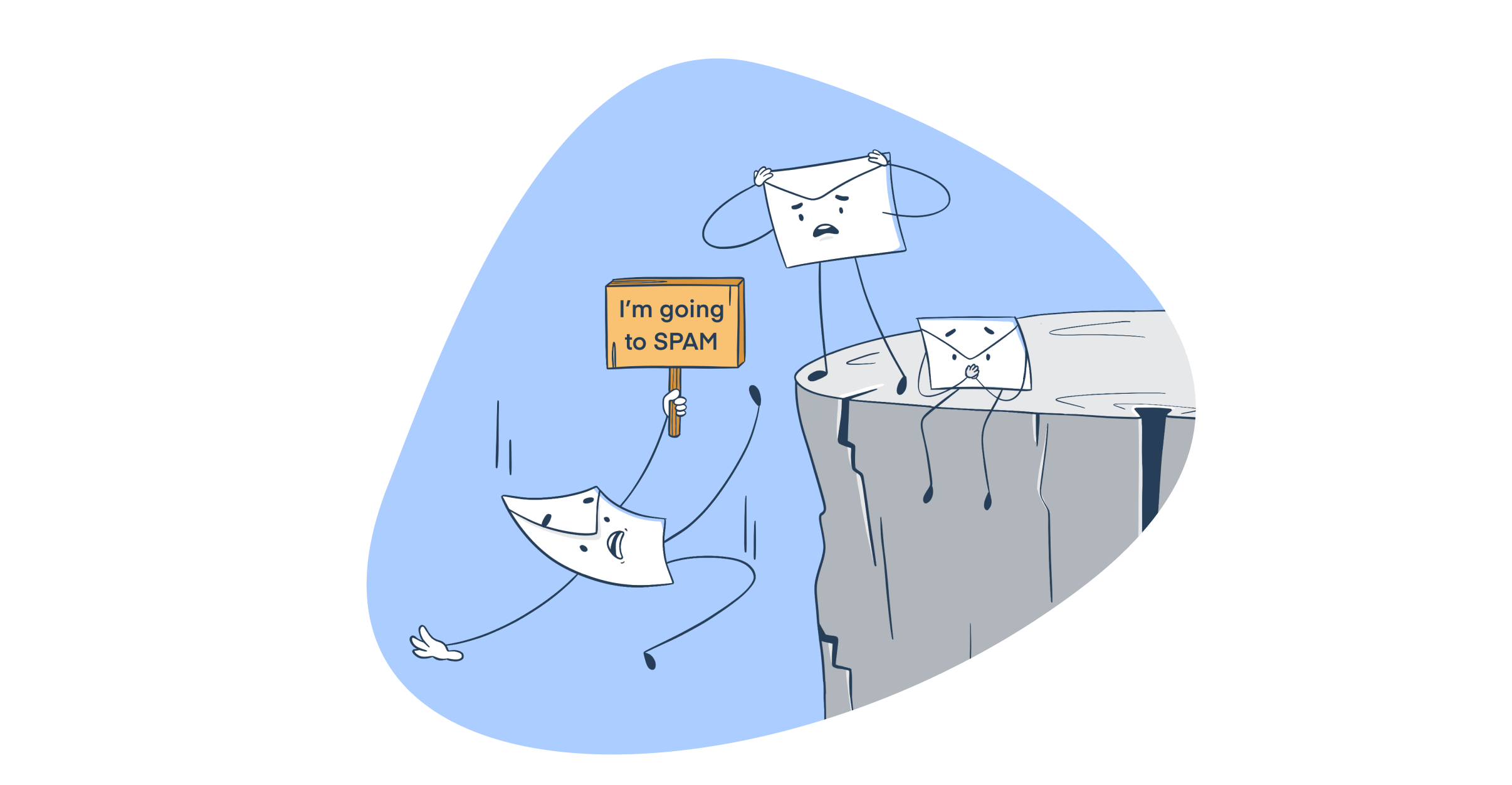In the fight against spam, ISPs (Internet Service Providers) put more and more restrictions on access to the user’s mailbox. This all works to the users’ benefit – it lets them have a clean mailbox with content they want to receive and an experience they expect.
But time and time again, important messages miss users’ inboxes due to sometimes foolish mistakes the senders make when in a hurry or due to lack of experience. Don’t let this happen to you.
Bear with us as we cover the basics of email deliverability, and suggest what to focus on and what to avoid in this 2023 updated guide.
What is email deliverability?
Before diving into all of the ins and outs of email deliverability let’s define what it is. In layman’s terms, it is measuring and having solid knowledge of how well your marketing or transaction emails perform in terms of being delivered to a receiver’s inbox, thus also being known as inbox deliverability.
Email deliverability vs email delivery
These terms often get confused for being the same but are two separate things and it’s important to distinguish between them.
Email delivery is whether the recipient’s mail server accepted the actual email file and delivered it to the mailbox no matter the folder.
With email deliverability, the server accepts the file and delivers it to the mailbox, but the question is if it was placed in the inbox or spam, social, updates, or any other folder that rarely gets checked by the recipient.
So in other words email deliverability is the actual ability to get emails to land in the recipient’s inbox.
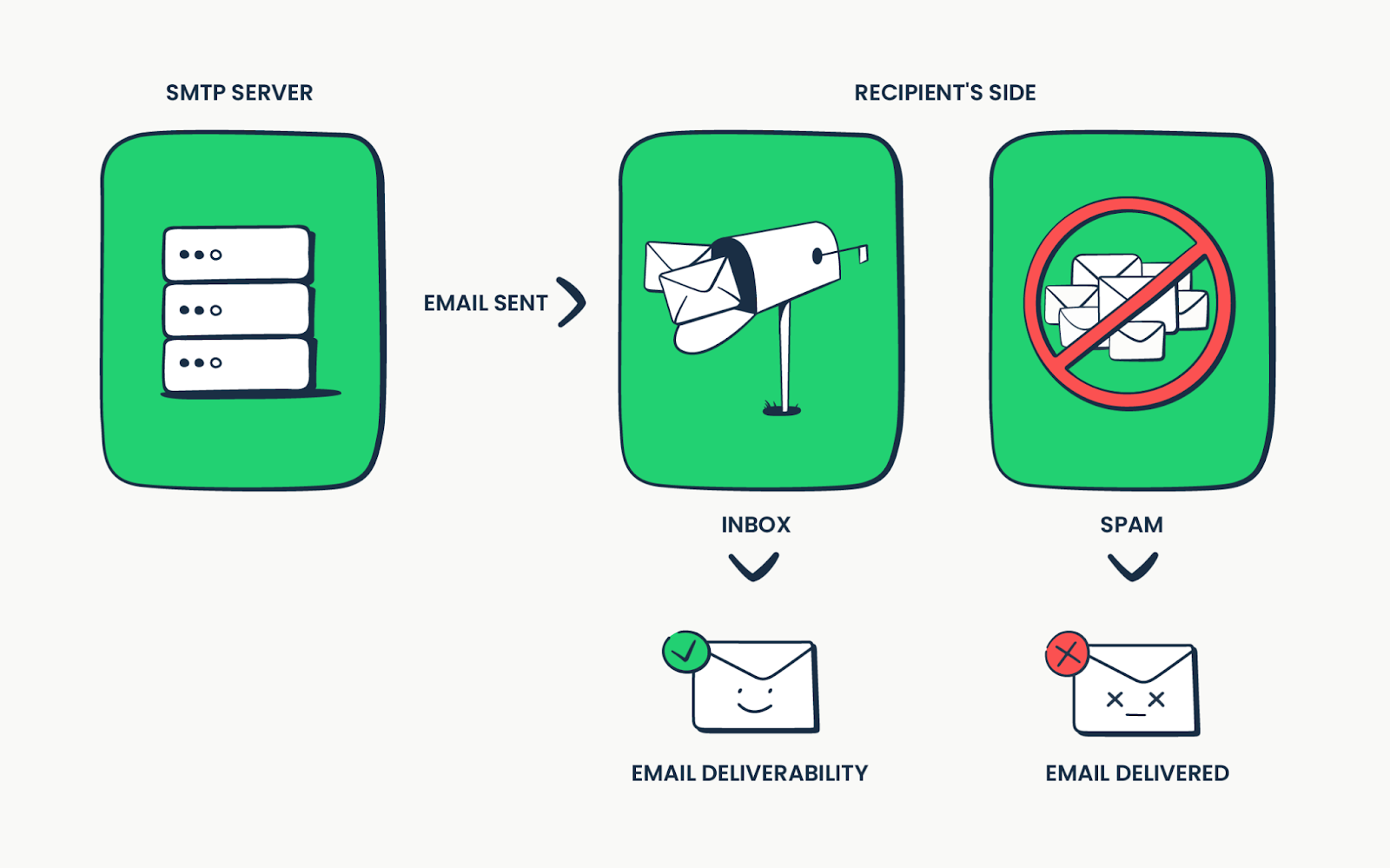
Why email deliverability matters?
A user forgot her password? Send her an email with reset instructions.
A new feature was just launched? Deliver the good news to your subscribers’ inboxes.
The traffic on the blog is slower than usual? Send a roundup of the latest articles to your mailing list. Companies send emails all the time.
Yet, according to the latest research from Influencer Marketing Hub, only 79.6% of legit emails reach their final destination. This means that, on average, every 3 out of 20 users (or a whooping 15,000+ users in a seven-digit community): 2022 Delivery Benchmark – Validity
- won’t regain access to their account immediately and might abandon your platform
- won’t know about that shiny new feature you’ve worked on for months and might flip to competitors offering the very same or even a less functional option
- won’t be reminded of your existence and won’t even consider one of your paid plans
If you can afford not to worry about it, we envy you. Most content specialists, however, will do their best to boost their delivery even by a single percent.
At Mailtrap, we deal with emails daily and we wanted to share the key things to consider when trying to improve deliverability.
What is a good email deliverability rate?
When it comes to determining what is a good email deliverability rate the answer is not a straightforward one.
In general, to get the most out of your marketing campaigns it is recommended to reach a deliverability rate anywhere between 85% and as high as 95%.
However, each business has its unique aspects therefore the number can vary.
What is recommended is to research your industry to understand how competitors perform and analyze your current email inbox placement rate and all the metrics related to it such as engagement rates, and what can be improved for better results.
After that, an email deliverability benchmark should be set and your email marketing team should collectively work to reach it.
Marketing emails deliverability rate
Generally, marketing emails tend to have a low engagement rate and are opened 20-25% of the time.
The good news is that for most industries, an open rate that is over 30% it’s already considered to be good.
So if you used an email warm-up service to get an extra boost and only got a 5-10% increase in open rate, that is a solid result.
Transactional emails deliverability rate
With transaction emails, it’s a different story since most of the time users are expecting to receive them and consider them to be legitimate emails before they are even delivered.
Thus most transaction emails have deliverability and open rate as high as 80-85%. But just because they have a higher rate, due to their nature, doesn’t mean they should be excluded from tests that can always help you reach better results.
How to test email deliverability?
Today there are a number of tools, many of them free, that allow you to build a proper email deliverability test, check different aspects of deliverability, and measure how your emails perform:
- Mailtrap Email Testing – use Email Sandbox for testing your email workflows in a safe environment. Check how emails look in various clients, analyze their spam scores, and test if they’re properly delivered, without the risk of spamming recipients.
- Sender Score – lets you assess your domain reputation and gives its “Sender Score” for each IP address that you’re known to be sending emails from. Additionally verifies critical authentications and related website certificates.
- MXToolbox – a set of tools for validating the reputation as well. We’ve mentioned earlier their Blacklist tool but they also have others for validating your authentications or checking the domain health (among others)
- Mail-tester.com / Isnotspam.com / Spamcheck by Postmark – additional tools for basic reputation checks. Send an email to an individual address and within seconds get a detailed report with improvement suggestions.
- GlockApps – an email spam test tool that helps you fix email deliverability and authentication issues.
- SendForensics /Kickbox – other paid but more robust email deliverability testing solutions that are worth consideration.
Although it’s not a recommended practice, email testing can also be done manually. We cover the ins and outs of that in our dedicated Mailtrap tutorial:
What affects the email deliverability rate?
There is a number of aspects that cause email deliverability issues, some of the main one tend to be:
- Amount of received spam complaints
- Content of the email
- Sending volume of emails in a particular time frame
- The infrastructure used to do so
However, email deliverability problems can be significantly reduced if things are properly tracked and improvements are made. Let’s take a detailed look at how this can be achieved.

How to track email deliverability?
If you tested all your campaigns before sending and the results are satisfactory, you probably want to know if the emails were indeed delivered.
There’s no way to know if an email landed in an inbox, not in a spam folder for example. But thorough email deliverability monitoring in recent years became an industry standard.
The process usually consists of tracking whether an email was opened or if links were clicked. Nearly every major email software comes with such analytics built-in and there are a number of tools such as Mailtrack to add them to your personal mailbox.
For email deliverability tracking, sending platforms usually attach a tiny, transparent tracking pixel to emails.
This file, usually the size of 1px to 1px, is invisible to users, doesn’t affect the deliverability, and is able to let the platform know immediately when an email is opened and links are clicked.
It also lets you understand the users better, know which device they use to open an email, what the operating system is, and which app they use for this purpose.
Unlike cookies on websites, there are no laws regulating tracking pixels (yet) so you’re free to use them with all your campaigns, without the need to ask for users’ permission. However, keep in mind that data collection via tracking pixels is still a controversial topic. Due to that, you need to make sure that the way you collect, store, and manage personal data has to be GDPR-compliant.
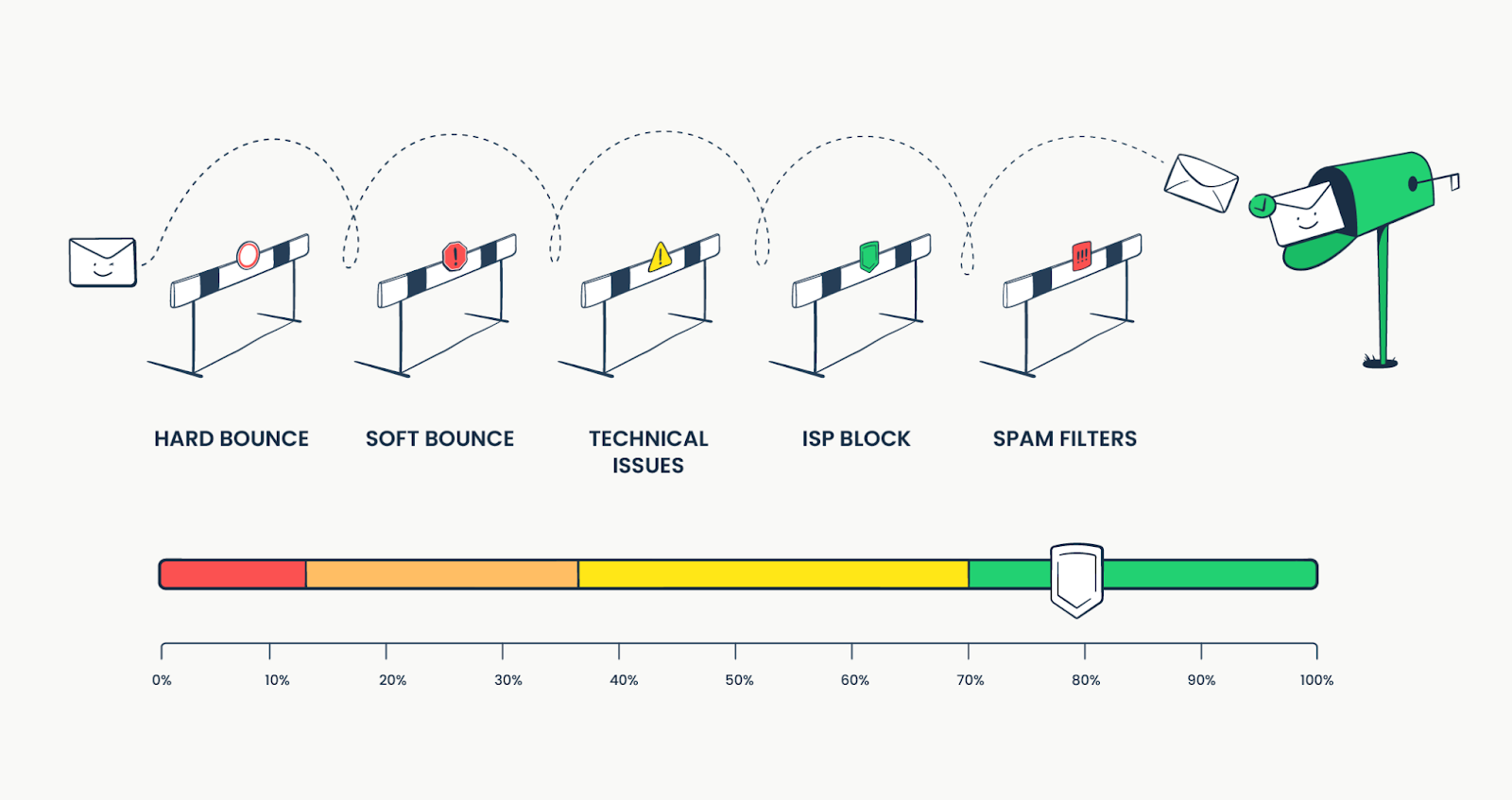
How to improve email deliverability: Best practices for your email campaigns
When it comes to email deliverability best practices, there are plenty of things to consider. Both Google and Yahoo, recently published the updated sender requirements for 2024, click the links to check them out.
Of course, we’ll discuss the requirements going forward, plus add suggestions from our experience. We’ve split these into sections, and for each assessed how easy it is to implement it (skill-wise) and as well as how time-consuming and how important they are for your success.
For each, we use a scale of 1 to 5, where ‘1’ means a really easy and quick fix and also high importance, and ‘5’ means a very difficult and time-consuming implementation as well as the least important. Let’s start!
Building the right reputation
- Easiness to implement: 1 / 5 (doesn’t require any tech-savviness)
- Time to implement: 5 / 5 (building a reputation takes time)
- Importance: 1 / 5 (reputation is everything)
ISPs care a lot about the credibility of your domain and IP address. Before any email is delivered, they’ll run a so-called ‘reputation check’.
The aim is to see whether you’re likely to be sending unwanted messages or have nefarious motives. If deemed that you do, your deliverability will suffer.
To avoid such a fate, focus on building the right reputation from your first campaign:
Send emails only to users who want to receive them
While buying mailing lists is an obvious no-no, you should also be careful about emailing people who didn’t give you explicit permission to do so.
Just because someone joined one of your events a few years back or signed up on your forums back in 2010, doesn’t mean they will appreciate being notified about your new product launch.
If they don’t, they’re likely to mark your message as spam to get it out of their inbox. Even a few such requests are enough to significantly harm the reputation of your domain and get you blocked on future campaigns no matter the DNS server you use.
Try to resist the temptation of contacting random accounts who MIGHT be interested in what you have to say (but likely are not).
Make it really easy to unsubscribe
This might sound counterintuitive. After all, you’ve been working so hard to gather your mailing list, why would you let them go so easily now?
You’re probably also subscribed to some mailing lists (voluntarily or not) but hardly ever even open their emails.
It could be that you signed up to access some e-book or tried a product years ago but don’t really care about it anymore.
Or maybe you were genuinely interested in some blog but, for whatever reason, just can’t be bothered anymore.
There are hundreds of such people on your list and if they don’t interact with you now, there’s a close-to-zero chance they will in the future.
If you make it hard for them to remove themselves from the list, sooner or later they’ll want to clean the mailbox by hitting the ‘spam’ button and quitting anyway.
What’s more, ISPs also look at whether people interact with your emails when assessing your reputation. If they never open them, it won’t help your cause.

One thing to keep in mind – people might not necessarily want to unsubscribe from all your communication.
Chances are they’re just receiving too many emails or are more interested in a different area that you also cover with your content.
Consider setting up a simple ‘preference center’ where users can decide what they wish to receive and how often.
Everyone likes being in control and some will stay with you longer if you give them that option.

Bounce Rate: hard bounce and soft bounce
Letting people unsubscribe easily is not enough. You should also remove some contacts on your own.
Believe us or not but list hygiene makes a lot of sense, after all, who needs inactive subscribers? The obvious case is bounced emails:
- Hard bounce – an email failed to be delivered due to a permanent issue (e.g. wrong email address) and the server will not be making more attempts to complete delivery.
- Soft bounce – an email failed to be delivered due to temporary issues (e.g. full mailbox) and the server will make more attempts to complete delivery.
If your mailing software doesn’t automatically remove accounts that resulted in a hard bounce, do it manually.
Even several hard bounces from one campaign can cost you a serious chunk of the reputation you’ve worked so hard to gain.
Nearly any email program for sending mass emails such as MailChimp or SendGrid offers detailed stats for each of your campaigns and accounts. You can easily check who opened your emails, who clicked on the links and how many times they did so.
This lets you quickly determine who hasn’t been active for ages and is just decreasing the quality of your list. Remove such users every now and then and focus only on those that appreciate your content.
Protip – some companies go as far as sending the inactive users an email saying, literally, “Hey. We’ve noticed you didn’t open any of our recent emails. Should we not bother you anymore?”.
What are the two most likely outcomes of such a message?
- the user unsubscribes and, as a result, improves the quality of your list
- the user stays on the list and actually starts interacting with your content
You win in both situations.
It could also be that these people don’t open your emails because… they’re not receiving them in the first place. Read on as we’ll be sharing many more tips on getting your emails delivered.
Follow a consistent schedule
Both users and ISPs appreciate companies that follow a regular schedule of sending emails.
Users are also more likely to open and interact with emails when they come on a regular schedule, for example, every Tuesday afternoon.
If you usually send one email per your regular weekly schedule, but suddenly switch to three, it might sound suspicious to the email provider. Resist the temptation of letting everyone know right away about a brand-new product.
Instead, integrate such a message into your existing campaigns.
Another reason to send emails at the right time is to increase conversion and improve your reputation. That 10-11 AM period on Tuesday sounds like a good start.
Many tools for sending emails let you send them at a specific time in the user’s timezone. If you have a distributed list from very different time zones, this will be a must.
Avoid spam traps and blacklists
Spam traps are fake email accounts set up by ISPs and placed in various locations around the web.
While harvesting emails, bots also tend to add these addresses to their collections as they look no different than the real accounts bots are after.
Send a single email to such an account and your deliverability will immediately suffer.
Those making such foolish mistakes and many other spammers end up added to multiple blacklists by various algorithms in place.
Many email service providers (ESP) such as Gmail, Outlook, or Yahoo Mail, before delivering an incoming email, check against those blacklists and decline emails if they find enough reason to consider someone a spammer.
Needless to say, you don’t want to be on any of the “naughty lists” that ESPs generate.
MX Toolbox has a free tool for checking if your domain already ended up on one of the blacklists.

Selecting the right infrastructure
- Easiness to implement: 4 / 5 (requires involvement from a dev team)
- Time to implement: 3 / 5 (for someone tech-savvy, it’s fairly easy). 1 / 5 if you opt for a private IP.
- Importance: 1 / 5 (the right infrastructure matters a lot)
Now, let’s look at a bit more technical aspect of getting your emails delivered to inboxes.
Spambots, in an attempt to get users to open their emails, are known to try to impersonate real people or organizations.
A phishing email sent from jon.snow@unicef.com with a request for donations is much more likely to bring $$$ than the very same email sent from jonsnow2487273@gmail.com.
To prevent that, ISPs implement several types of email authentication techniques to ensure the email originator is real. It’s quite easy to pass them if you’re a legit email sender so definitely invest a bit of time into this.
Authenticate with DKIM
DKIM stands for DomainKeys Identified Mail and is used for email validation. Meaning it checks If a given email message was indeed sent by the owner of a given email address.
It’s a digital signature that’s sent with every email message sent. It includes encrypted details such as message body or/and headers, sender’s domain and others.
When an email with DKIM is received by an incoming server, it will recreate the signature with a public key and compare it against the DKIM received.
If there’s a match, an email will get a significant boost in deliverability.
If it fails, it will be a hint for the receiving server that the sender might not be who he/she claims to be.
If DKIM is missing, it might not disqualify a message but will affect its deliverability.
Authenticate with SPF
SPF (Sender Policy Framework) is another important authentication method. Unlike DKIM, it doesn’t include any information about the domain or address that an email is sent from.
SPF records, however, tell an incoming server which hosts (or IP addresses) are allowed to send emails with a given email address.
Before an email appears in a mailbox, an incoming server does a quick check. If things just don’t match, an email might be rejected right away.
Which one should I use – DKIM or SPF?
Both. While they might seem like competing services, they’re in fact best used simultaneously.
DKIM is unable to verify who sent a message and SPF does it really well.
On the other hand, SPF doesn’t include any body and headers’ verification but that’s what DKIM was made for.
Using both makes it fairly clear to incoming servers that your emails are legit and you are who you claim you are.
Authenticate with DMARC
Just when you thought you were done with authentications, DMARC appeared on the horizon. And rightly so.
DMARC is the most sophisticated of all three methods, because it leverages both DKIM and SPF and adds an extra check (known as ‘alignment test’) on top of that.
DMARC also allows you to tip a receiving server on what it should do if an email fails the test.
Such messages can be either discarded right away, sent to a quarantine (usually a spam folder) or treated as usual.
Finally, for each test failed, a sender might receive a report with the details of what happened, providing a first-hand source of knowledge if any spoofing occurs or a legit email fails a test.
DMARC requires at least one of the previous two methods to be implemented. It certainly won’t hurt to have all three set up for better credibility and protection from cybercriminals.
Rely on double opt-in
Another thing worth setting up for any email campaign you’re planning to send is a double opt-in.
Typically it means that after a user signs up to receive your emails, they need to head over to their inbox and confirm the intent.
While adding a plain functionality doesn’t affect your deliverability, it affects the quality of your mailing list, bounce rate, and spam reports.
While it might be tempting to automatically subscribe people to a newsletter when they register for an event or open an account, you’ll get better results long-term if you explicitly ask them for consent. Doing so also keeps you compliant with the law.
Check feedback loops (and make use of them)
Nearly all major ISPs give you access to feedback loops. These are not some secret channels that users use to give you valuable feedback about your product.
These are these simple surveys that users are asked to fill out when they unsubscribe from a mailing list and can provide lots of valuable data.
Users complain about getting too many emails? Try decreasing your volume a little bit.
They claim they never signed up to be on your email list in the first place? Double-check if you’re sending your campaign to the right audience.
Remember, your IP address also impacts the sender’s reputation that comes with each of your emails.
Platforms for sending a number of emails at once offer by default shared IPs that are used by hundreds or thousands of their clients. This keeps the cost of the service low but doesn’t give you any control over your IP reputation.
The operators, however, do their fair share of quality control and rotate with hundreds of IP addresses to always ensure good deliverability for their clients. For nearly everyone, shared IP will be perfectly sufficient.
However, if you already have hundreds of thousands of contacts on your lists and need to reach out to them regularly, consider investing in a dedicated IP. This will give you full control over your sending reputation. It’s important, though, not to email the entire list on day 1.
Receiving servers need to be taught first who you are and that what you send is legit and desired by your audience.
Companies typically start with sending small batches of emails to some of their contacts and, step by step, increase the volume.
Crafting accurate content
- Easiness to implement: 2 / 5 (requires a bit of research but still fairly easy)
- Time to implement: 3 / 5 (needs a bit of a setup and, as mentioned, research)
- Importance: 3 / 5 (not as relevant as the first two parts but still needs to be considered)
Now, let’s discuss how to increase email deliverability when creating actual campaigns.
Use branding and personalize ‘from’ field
We mentioned earlier that one of the factors impacting the sender’s reputation is whether users interact with the email content or not.
One of the time-tested methods to increase the open rate is to include both your company name and the name of the sender. “John from Mailtrap” will likely have much more success with our mailing list than “John Smith” or, worse, “johnsmith48782”.
The company name adds credibility and a familiar feel while a person’s name makes it sound as though it’s not just the marketing team sending a new campaign but a regular person behind it.
Additionally, always have a short and informative text in the subject line that doesn’t come off as clickbait.
Of course, you don’t always need the CEO to personally compose and send each email that has perfect formatting, especially if you send onboarding messages to thousands of users, it’s virtually impossible.
It’s fairly common to receive an email from a CEO, respond to it, and be connected with the support team. And people are fine with that!
Send a welcome message
Right after someone signs up to your mailing lists or registers for a trial account, let them know what they should expect from you.
Send them a personal ‘thank you’ for trusting you with their time and let them know what’s coming up:
- When will you be contacting them (“we’ll be reaching out every Tuesday and Thursday afternoon to…”)
- What are you going to write to them and why (“we’ll send you various tips on how to get started”, “we’ll send you a weekly roundup of our best content to keep you up-to-date”)
- Giving them a choice (“if this sounds like too many emails, update your preferences here”)
- And something to start with (whet their appetite ;-))
Emails like this are an easy way to quickly start a relationship with a reader, gain their trust, and let them know that they’re in charge.

Avoid spammy titles
If you’ve got a legit mailing list and interesting content, you shouldn’t have to use BuzzFeed-like expressions to get people to open an email from you.
Spam filters are known to take topics and content into consideration. So even if you have a great reputation, a full set of authentications, and a highly engaged list, sending one “you won’t believe your eyes” email might fail to get it delivered.
Here are 455 examples of the phrases you just shouldn’t use in your emails. You can do better than that.
Send relevant content
People signed up to your list for a reason and hearing about the great deals for your product wasn’t probably one of them. Don’t misuse their trust. If you promised to send tips and tricks on using your product, don’t turn it into a sales channel.
If your users signed up to get your latest blog posts, they will expect to get those blog posts in every HTML email you send. If you fail to deliver on a promise, they’ll either leave (bad news) or mark you as a spammer (worse news).
Of course, you might mention a deal or related product every now and then, but keep it to the minimum. The 80/20 rule applies well here as well.
Keep 80% of the content for the relevant stuff and the other 20% for the content more related to your business goals.
This can mean that one out of five emails is a bit ‘off topic’ but probably a better choice will be a small section in most emails with a gentle CTA to buy your product/service.
Either way, test your feedback loops to see if such messages resonate with the audience.
Segment the list
Don’t just send emails to all your contacts, hoping there will be some interest.
Segment users based on their interests, types of features they use, and content they interacted with in the past.
The better you understand your audience and the more relevant content you send, the better reception you’ll have at the end of the day.
Use analytical tools like Mixpanel to see exactly how users navigate around your platform and apps. It will give you tons of data on what they’re interested in and will let you adjust your content accordingly.
If you run several blogs or have multiple content strategies, try to also target content to specific groups, rather than to all your contacts at once. A bit of effort can yield some pretty nice results.
Don’t use no-reply emails
No matter the size of the company and mailing list, you want to hear back from users. Whether they come with questions about a product, complaints about too many emails, or feedback/feature requests, the information can be very valuable.
While not of a significant value, ISPs also tend to favor those who send emails and accept responses with legitimate addresses.
Email deliverability tools
There are many, many options available. Many offer free tiers for those sending few messages. Each comes with a free trial so you can test the capabilities of a given software.
It’s important to choose credible tools with an established reputation of IP addresses and features that match your business needs.
These platforms employ many email deliverability experts so they can also assist you in improving your campaigns. Here are a few of our recommendations:
- Mailtrap Email API gives devs more control over email deliverability and allows them to quickly fix any existing sending issues before they occur. On top of speedy troubleshooting and debugging capabilities, Email API has an impressive Sending throughput of ~10,000 emails/second.
- SendGrid is one of the biggest players on the market that specializes both in transactional emails and marketing campaigns. You can use their robust API to connect their features to your platform. SendGrid also offers various tools for designing beautiful and successful emails.
- Sendinblue (now Brevo) also offers both transactional and marketing communication. It also comes with plenty of additional capabilities, such as SMS messaging and marketing automation.
- Mailchimp has all the tools you could think of for building marketing campaigns and automations. This includes templates, a drag & drop email builder, and detailed analytics. Mailchimp also owns Mandrill, which is one of the most popular tools for sending transactional emails.
- Mailjet is another popular tool for sending both transactional emails and regular newsletters. It’s probably the most affordable of all these tools while offering similar capabilities.
Email deliverability checklist
As you probably already understand having good email deliverability takes time, knowledge, a lot of testing and adjusting, following guidelines, and patience.
This is exactly why we prepared this email deliverability checklist that contains all of the above-mentioned points
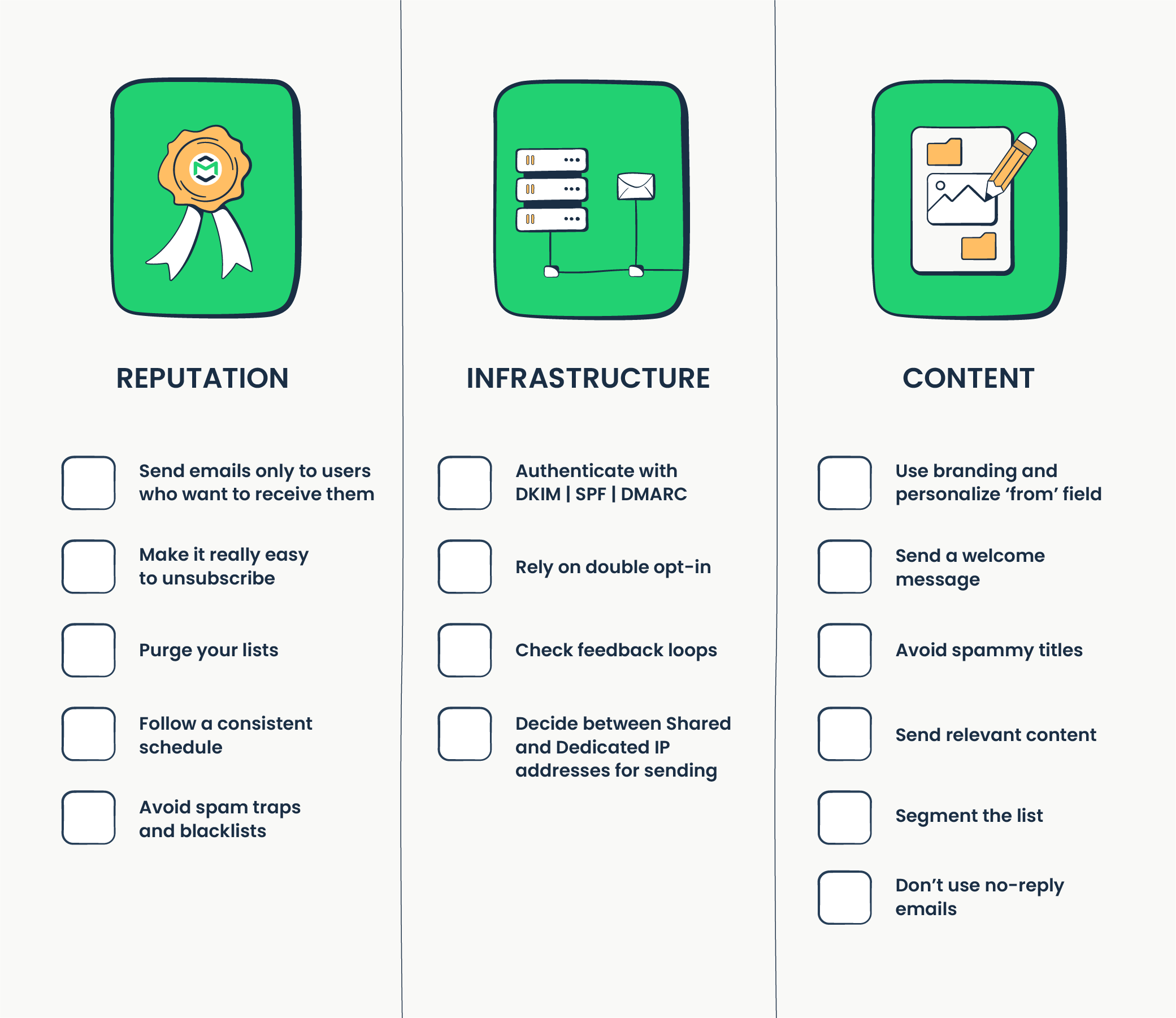
Summary
This sums up our email deliverability guide. We hope the tips presented were useful and helped you improve your delivery rates.
On our YouTube channel, we also cover email deliverability and AI, so make sure to give that a watch:

